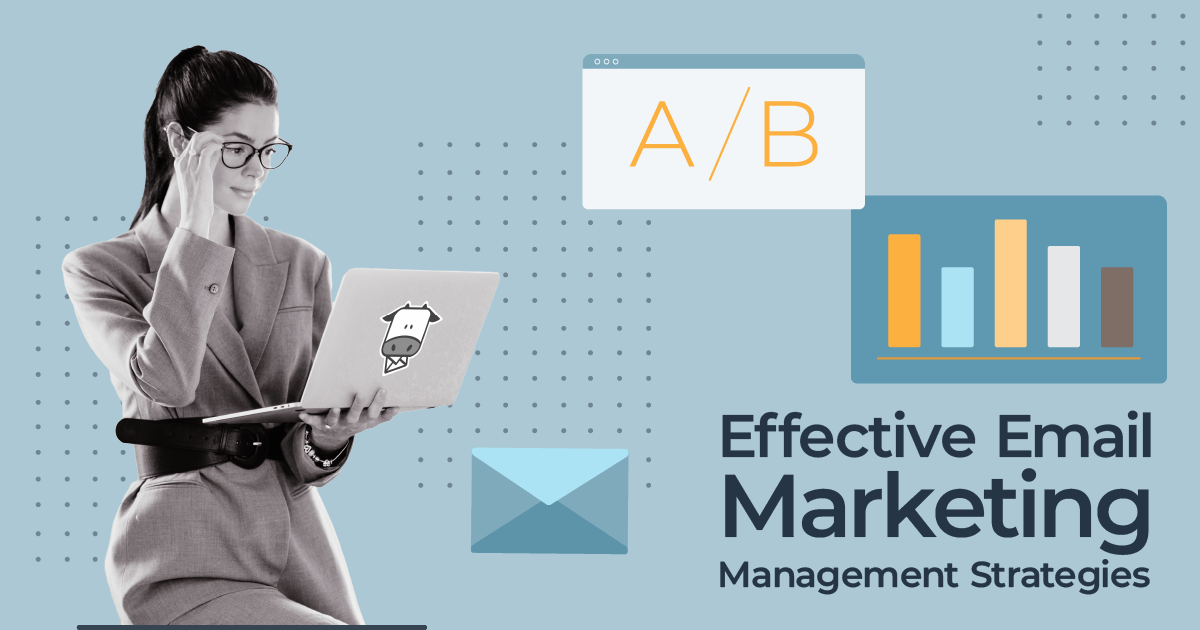
How To Repurpose Blog Content for Email Newsletters
You’ve worked hard to produce high-quality content for your blog and share your wisdom with your readers. Your efforts have paid off with steady organic traffic and high rankings. Plus, you repost every new resource on social media to gain more traffic. But is this the only way to grow your reach?
“Yes, I can tell where this is going…”
In this guide, we’ll show you how to repurpose your blog content into email newsletters that will delight and engage your audience. Think of it as giving your content a second life. Not only will this save you time and effort, but it will also ensure your valuable insights reach a wider audience, boosting engagement and driving more traffic to your site.
Carry two faces under one hood
Turn your blog posts into emails and reach people where they are.
Start for freeWhat Is Blog Content Repurposing?
Repurposing content–also known as content recycling–is the process of reformatting and reusing existing content to expand your outreach. For instance, content creators can turn popular blog posts into infographics or YouTube videos into podcast episodes to attract new audiences. They use different content formats based on the audience’s needs.
Creating original content is not always easy. It requires time and resources that will be simultaneously taken away from other substantial content marketing tasks. This is a challenge, especially for freelancers or small business owners.
Repurposing blog content into email campaigns is a fruitful tactic for bloggers, publishers, and content creators to showcase their latest, most popular, or old blog posts. They can ensure that their valuable content reaches the audience, even if they don’t visit the blog regularly.
Check out Moosend’s content newsletter to get a better grasp:
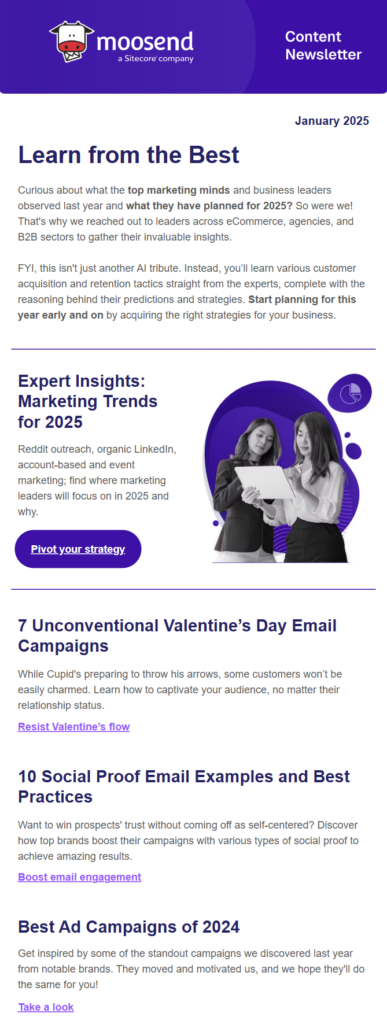
This digital marketing tactic is cost-effective and offers opportunities for high personalization. For instance, you can send different content to subscribers based on their preferences, engagement level, and interests.
To put this strategy into motion with fewer blockers, marketers use email marketing tools like Moosend with multiple capabilities for blog sites, such as templates, audience segmentation, and RSS feeds.
Benefits of Repurposing Blog Content for Emails
Let’s explore some of the top benefits of giving new life to your blog posts and sharing it via your email channel:
- Expand your reach: Find your target audience where they usually hang out by sending targeted email campaigns.
- Boost your email traffic: Bring more traffic to your website by sharing your blog posts through email campaigns.
- Strengthen your SEO efforts: Sharing your blog content on various channels, including email and social media platforms will also increase your website traffic and ultimately your SEO efforts.
Overall, think of repurposing your blog posts for emails like giving your content a makeover. It’s all about maximizing the value of what you already have and presenting it in a fresh, engaging way.
8 Strategies for Repurposing Blog Content to Emails
If you’re interested in starting or improving this content marketing tactic, follow these steps:
1. Grow your email list
If you’re a beginner in email marketing, you need to get your readers’ opt-in before mailing them. Add a subscription form on your blog to collect email addresses. For instance, you can add a pop-up or static form or create a dedicated landing page.
To send more targeted emails, add a preference center and segment subscribers into distinct groups based on choices. Content topics or email frequency are among the variables you can add to your preference checklist.
Here’s a signup form from The School of Life:

Most email automation software offers forms and landing page builders to help users start their email collection process fast. To convert more visitors, mention why they should subscribe and share an incentive with them, such as one-month access to your exclusive content.
2. Identify blog posts worth repurposing
What pieces of content would you repurpose first? Would you choose evergreen content that already receives traffic consistently, or would you repurpose old blog content to revive it? You don’t have to go one way or another; experiment with different content strategies based on the goals you set each time.
Here are some use cases to consider:
- Share your latest blog updates to increase your blog traffic.
- Showcase time-sensitive content, such as seasonal resources.
- Revive old content to improve search engine rankings.
- Share case studies and other forms of social proof.
Remember that your repurposing strategy won’t be static. You can test out different blog posts and formats to spot what works.
Finally, if you decide to repurpose old blog posts, refresh the existing content and optimize it for SEO to boost performance.
3. Adjust your tone and format
Repurposing is rarely a copy/paste gig. You can’t just insert the blog content into an email template without altering the format and tone of voice. Most bloggers create roundups with a collection of articles. They write catchy copy for each one and add call-to-action buttons redirecting subscribers to the blog posts.
If you want to promote a single content piece, write an engaging summary with the key takeaways to motivate subscribers interested in this topic to click. You can also include relevant quotes and stats to make them more appealing.
Finally, you can also repurpose an original post into an email course. Set up an email series to educate your audience on a topic that excites them. Remember, an email is a more direct piece of content than a blog post. Adress your readers as if they were colleagues or partners, sticking to your brand tone, to grab their attention faster.
Look at this example by The Infatuation to get inspired:

4. Add visual content
While plain text emails can occasionally be effective in terms of engagement, adding visuals, video content, or GIFs to your email campaigns can give metrics a real booster. Especially when they complement the email copy perfectly. Why? Because they help improve user experience and navigation.
If you lack design resources, visit stock photo sites and find free or affordable images that suit your style. Plus, user-friendly tools like Canva can be valuable for certain types of content, such as infographics.
Most email services let users insert those visual elements easily into premade or original templates in simple steps. Customize them by adding your brand assets and create a consistent experience across different platforms to avoid confusing readers.
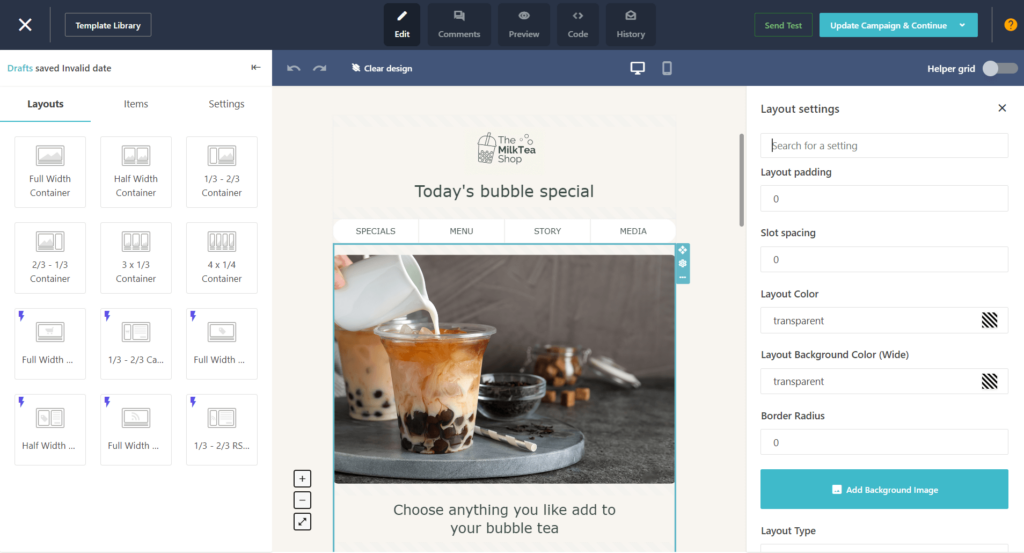
5. Create attractive subject lines
Want to ensure that your repurposed email content will receive the open rates it deserves? Create clear and concise subject lines, giving readers a glimpse of what to expect inside. The goal is to stand out in a crowded inbox and entice readers to click and explore your content.
Use action-oriented language and create a sense of urgency or curiosity. Let’s imagine that you’ve created an educational email series with blogging tips. Here are three subject line suggestions:
- Unlock the Secrets to Boosting Your Blog Traffic
- Don’t Miss Out on These Exclusive Tips
- 🚀 Ready to Skyrocket Your Blog Traffic?
Not sure if your subject line is effective? Use an AI writing assistant to help you out. For example, Moosend has a built-in AI-powered tool to let marketers nail their copywriting efforts.
6. Personalize repurposed content
While sending a blast email to all your subscribers is convenient, it’s also a bit risky. Especially if you cater to readers with different interests and reading preferences. The good news is that most email marketing software offers personalization tools that can remove that barrier and tailor your repurposing marketing strategy to your audience’s needs.
For instance, you can segment your audience based on criteria, such as previous behavior and engagement. You can also use custom tags to group them based on the criteria they set on the preference center.
Personalization doesn’t stop there. You can also add the subscribers’ names on the subject line or email content through custom fields or experiment with different formats using A/B testing. Not only will you improve your metrics, but you’ll make subscribers feel acknowledged, too. A win-win scenario.
7. Set up automation workflows
One of the biggest assets of email marketing is its automation capabilities. You can trigger email campaigns based on specific actions via repeatable RSS campaigns and similar workflows to send more timely messages to your audience and convert them faster. Plus, when you create automated workflows in advance, you save time and effort.
For instance, you can create an email course by giving a new format to an existing article and sending different sections once per week. Or you can set up a series of emails with repurposed blog content for people who download a lead magnet, such as templates or tutorials with relevant tips.
Most marketing automation services provide users with top-notch automation features, such as premade recipes to make this process smooth even for beginners. The end goal is to give readers an improved user experience and drive better results for your blog.
8. Monitor key metrics
To optimize a strategy, you need to analyze relevant data and make data-informed decisions. Here are some important email metrics to monitor:
- Open rates
- Conversions
- Click-through rates
- Bounce rates
- Unsubscribes
- Spam complaints
Once you spot certain patterns that impact the performance of your repurposed blog content, you can try new things or stick to what works. You may have to reconsider parts of your strategy and repurpose your blog content for social media or your YouTube channel instead.
Repurposing Newsletters to Blog Posts
Now let’s explore the other side of the coin: Is it worth turning an email into a new post for your blog? If it received high engagement rates, covering a unique angle that’s missing for your blog, then yes.
First, identify those emails and spend some time to analyze why they grabbed your audience’s attention. It will help you reuse and reformat the content, following the tone of voice of your blog. Then perform research to provide in-depth insights to readers and perform SEO optimization to improve rankings.
When your blog post is ready, promote it on different channels, such as LinkedIn to gain more traction. And if you find this process time-consuming, spot an old post with similar content, and information from your newsletter and republish it. A fresh outlook can work miracles.
Maximize Your Content Reach Through Repurposing
Repurposing your blog content for email newsletters is a smart and efficient way to keep your audience engaged while maximizing the value of your existing content. By expanding your reach, boosting email traffic, and strengthening your SEO efforts, you can ensure that your valuable insights are seen by a broader audience.
FAQs
Before you go, check out these frequently asked questions regarding content repurposing:
1. How does repurposing content contribute to brand authority and credibility?
Repurposed content creation helps businesses engage with a bigger audience, show them their expertise, and set the right expectations regarding their offers.
2. What are the best ways to repurpose blog content for social media?
Find the top social media channels for your audience and create snackable content snippets, such as infographics or SlideShare presentations.
3. Should you repurpose only old content?
Not necessarily–you can also repurpose new content that you think will resonate with your audience at a certain time, or popular evergreen posts to gain more traction.
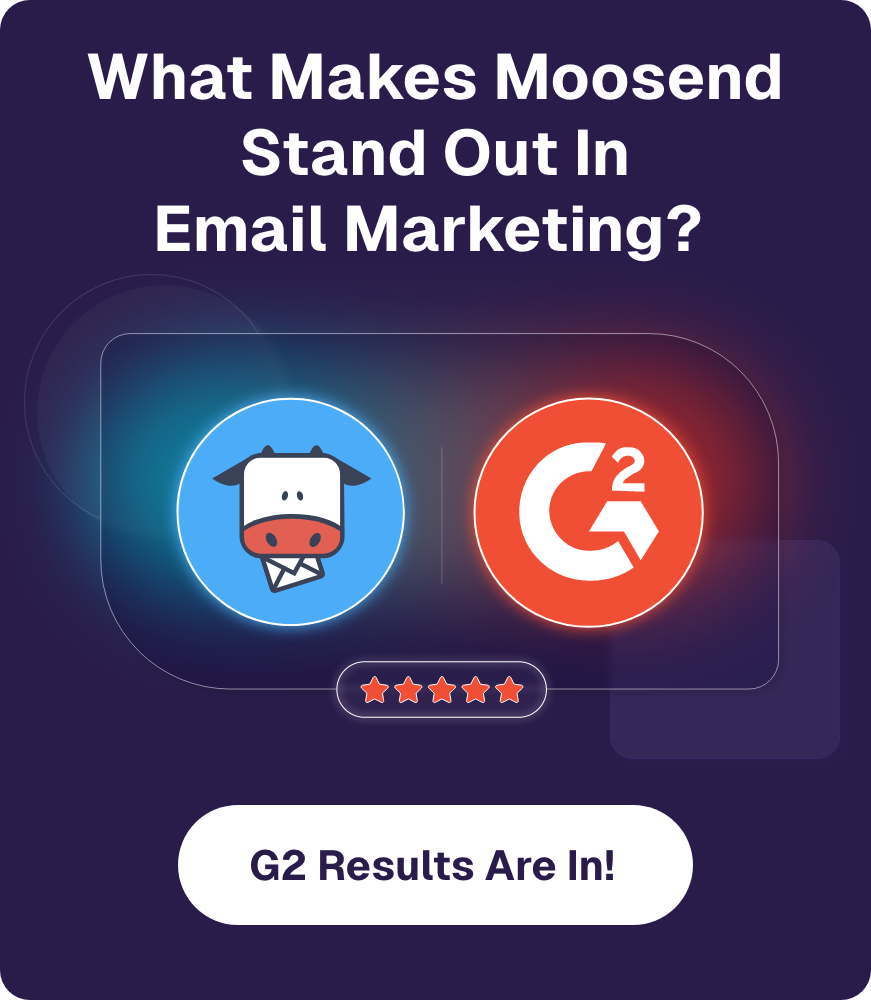
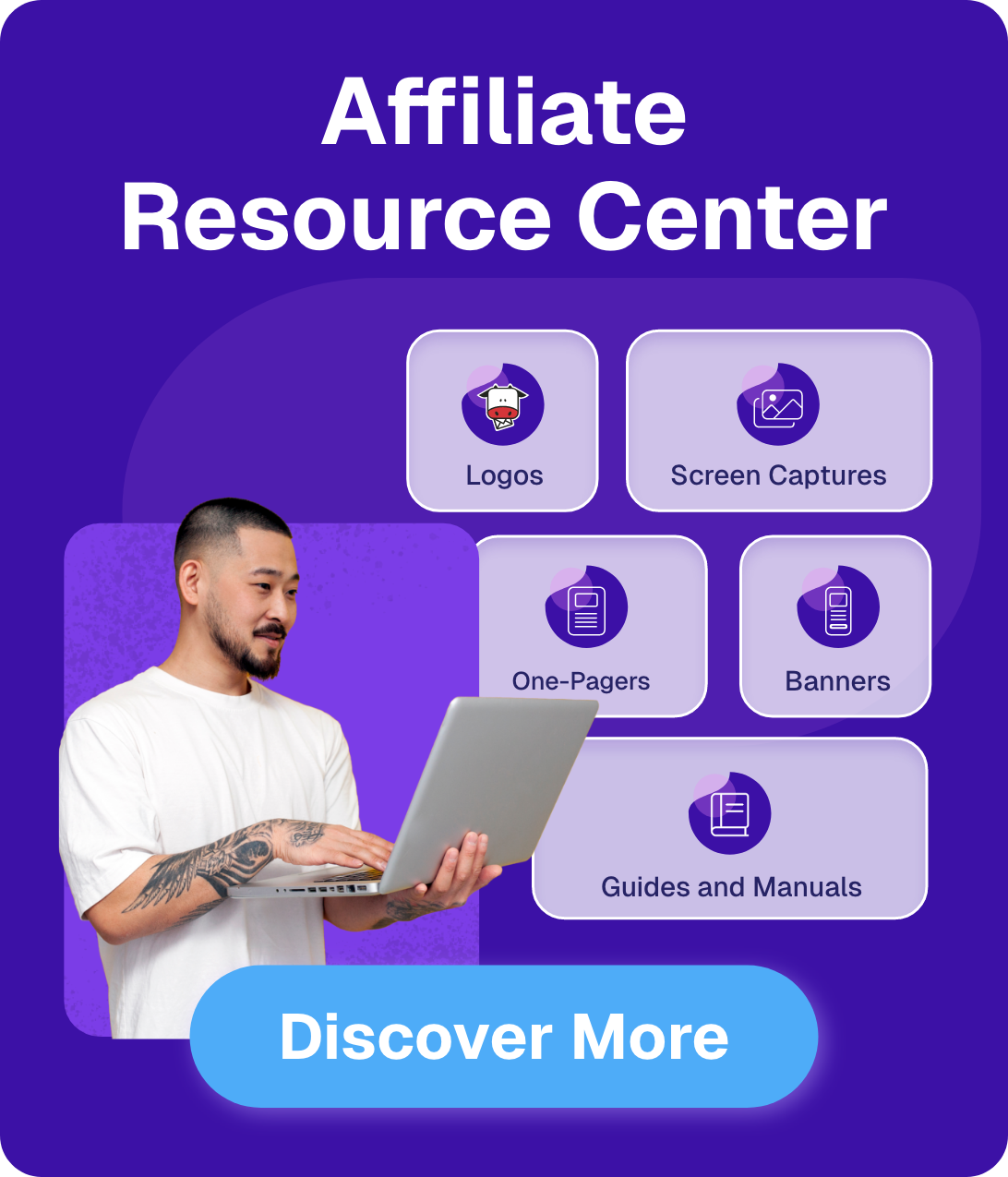

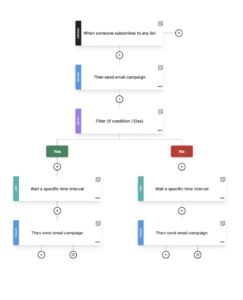

 Published by
Published by
